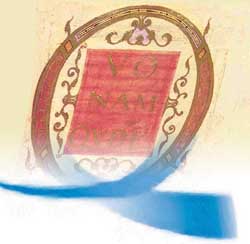Free excerpt!
Chapter Five
WHAT IS THAT ridiculous monstrosity doing?” asked St. Bernard of the statues in the cloister at Cluny.
“What is that deformed beauty and that beautiful deformity? Those unclean monkeys? Those ferocious lions? Those battling knights? Those monstrous centaurs? Those huntsmen sounding their horns?
“Here are several bodies under a single head; there a quadruped with the head of a serpent; there a fish with the head of a quadruped...”
A millennium ago, this was the fabulous interior world of Cluny. A sort of monastery within a monastery where the monks were sequestered from the world, St. Odilo's cloister was built with marble procured from Provence and shipped up the Rhone and Saone rivers to Burgundy in the foothills of the Alps.
Here the Cluniacs slept, studied, ate and prayed in strictly regimented silence. Some verbal conversation was allowed after morning chapter and after dinner, but after Compline all talking ceased. Once a Cluniac monk guarding horses belonging to the abbey let one be stolen rather than sound the alarm during the Greater Silence.
The stillness of the cloister was supposed to invoke the eternal silence of God, uniting the monk with the object of his adoration, although actually communication continued by means of an elaborate sign language. “The novice must needs learn the signs with diligence,” noted Ulrich of Zell, “for after he has joined the community he is very rarely allowed to speak.” St. Bede could express every number up to 9,999 on his fingers.
The monks all dressed the same, with brown tunic, girdle, and scapular, a piece of cloth worn over the shoulders that hung down in front and back, commonly called the “yoke of God.” The cowl, or hood, completed their everyday garb. This uniform conferred an element of anonymity (Cluniacs were forbidden to enter the lavatory with their heads uncovered), but it could not alleviate the complete lack of privacy.
In the cloister, even the smallest personal matters were transformed into closely supervised, highly regimented group activities. On infrequent bath days at Canterbury, the monks were quickly herded in and out of the water by a senior monk. At Cluny, the razors were locked up until the shave, which was proceeded by the chanting of psalms. Bloodletting was so great at these events, however, that some monasteries brought in secular barbers for the task.
Cluny's spirit was established by its first abbot, St. Berno, who came from the monastery of Baume, an isolated outpost of Aachen authoritarianism that had survived the dismemberment of the empire. He founded Cluny on the Duke of Aquitaine's estates during first decade of the tenth century. Sixteen years later he was succeeded by St. Odo, who also came from Baume, where he had been oblate master. |
|
The History of the Corporation
|

Astonisher.com is pleased to present The History of the Corporation, Volume One by Bruce Brown.
Here is the Table of Contents for excerpts from the entire book, which covers 1,000 years from the birth of the first modern corporation through the the First Dominion of the corporation.
About the Author: Bruce Brown is the author of eight books, including Mountain in the Clouds, an environmental classic, and The Windows 95 Bug Collection, which was put on display in the Smithsonian Institution in Washington, DC.
He has done investigative reporting for the New York Times (the Karen Silkwood story), foreign correspondence for Atlantic Monthly (baseball in Cuba), and book reviews for the Washington Post Book World, as well as script-writing for PBS-TV (The Miracle Planet).
He is also a successful businessman and CEO, having created BugNet and built it into the world’s largest supplier of PC bug fixes before it was acquired by a Fortune 500 company at the height of the dot com boom.

|
|
|
The distinctive Romanesque design of Cluny has been traced to several wildly divergent sources. Some have seen signs of Moorish influence, while others have maintained that the building was based on several systems of musical numbers, such as the Pythagorean series of 2, 3, 4, 6, 8, 9 and 12. The link between music and architecture at Cluny was physically embodied in two exquisite capitals from the ambulatory which depicted the eight tones of the Gregorian chant in human form.
Odo believed that most people, as petty slaves to concupiscence, were doomed to eternal damnation. The only hope for heaven lay in becoming a monk, and withdrawing from normal life. The individual ego, will, and emotions were to be suppressed so completely that the monk “died to the world.” Above all, physical pleasure was to be avoided. There is even record of an English monk whose door to the orchard was walled up because he took too much enjoyment from it.
And those activities that were allowed (such as writing and illuminating texts) were prescribed, almost grudgingly, because they had a higher use in fighting the allure of greater pleasures. Thus Abbo of Fleury advocated literary pursuits to Fulbert of Chartres because he believed they did most to bridle lust. Literature led to its own sins, though, most notably pride. Eadwine, a monk at Canterbury, wrote on his own self portrait, “I am the prince of writers; neither my fame nor my praise will die quickly...”
At night, the Cluniacs hived together in the cloister dormitory. The rule of Cluny decreed that only the monks' feet and arms could be uncovered, even in the hottest weather. Rectors patrolled the dormitory to insure compliance. Awakened between two and three in the morning by a peeling bell, the monks of Cluny filed down the stairs from the cloister to the great church of Cluny, then the largest in the Christendom.
Rebuilt and expanded three times over the course of three centuries until it reached 600 feet in length, the cathedral at Cluny towered over the abbey's extensive collection of buildings and workshops. It was the first medieval European structure to attain an interior vaulted height of 100 feet. In 1125 it also became the first 100-foot high ceiling to collapse, but the pointed barrel vault was rebuilt five years later.
For 700 years plainsong resounded in the great Church of Cluny as the monks' Gloria en excelsis rose to the massive “Christ in Glory” fresco in the apse, which was reportedly “painted like a manuscript page.” During major festivals the high altar was illuminated by a forest of candles surmounted by a gold pyx which glistened with precious stones. The cantors wore magnificent copes, while circulating thuribles incensed the altar and crowd of worshipers at night services.
It was at services like these at the Abbey of Gorze that medieval drama was born. The Easter play of the Sepulcher first appeared in the Gorzer group during the tenth century. Performed on the night of the Resurrection, the service featured three monks in albs who approached the sepulcher slowly from the far end of the church, as if searching for something. When they drew near, the monk seated there began to sing softly, “who is it you seek in the sepulcher, O worshipper of Christ?”
Although the abbeys of Gorze and Cluny both followed the Aachen model, Cluny developed a liturgy of its own which was less dramatic but much more lucrative. Cluny made a frank practice of exchanging prayers for material donations. In fact, the pattern was set in 909 when William of Aquitaine set off with Abbot Berno to reconnoiter a suitable spot for a new abbey. St. Berno selected the richly wooded valley of Cluny. William protested that Cluny was a favorite hunting spot, but the monk retorted: “Which will serve you better at the judgment, O Duke, the prayers of monks or the baying of hounds?”
The Catholic Church had long sought donations from the pious in remedium animæ, to save their souls. Before the end of the Roman era, St. Augustine urged Christians to “consider Christ among their children and make Him a partitioner in their inheritance.” In 772, when Charlemagne granted privileges to the abbey of Lorsch “that thereby we may merit pardon from the eternal giver of rewards,” he was repeating an old formula used by sovereigns before him. So Cluny did not invent what C.H. Lawrence has called “the economy of salvation,” but it did exploit the pecuniary possibilities more systematically than any before...
"The History of the Corporation, Volume One" © Copyright 2003 Bruce Brown
Jacket illustration and design by Running Dog.
|
This is a free excerpt from The History of the Corporation by Bruce Brown.
The complete book is now available for Kindle on Amazon...

|
Key words from the remainder of Chapter 5 of
The History of the Corporation, Volume One
monastic offices
Lauds
Prime
Terce
Sext
None
Vespers
Compline
Matins
Dead
All Saints
Laud perennis
books of Genesis and Exodus
Lent
Ulrich of Zell
Pope Benedict VIII
St. Odilo of Cluny
929
955
981
1010
Church of Sainte-Marie at Huillaux
relics of St. Leotadus
1049
river Adrieres
Auvergne
Bourbons
Liber Vitæ, or Book at Life
confraternities
King Athlestan
altar of the basilica at St. Gall
William the Conqueror
Gunrada
Cluniac priory of Lewes
priory of Villars-les-Moines in the diocese of Lausanne
sheep on the South Downs in Sussex
wool
export business
St. Berno
Aachen model
abbacy of St. Hugh
Aurillac
Charite-St.-Loire
dependent priories
France
England
Switzerland
Germany
Italy
Spain
General Chapter
Aachen decrees
Gottschalk
Carolingian kings
Norse onslaught
St. Mayeul
Peter the Venerable
1156
in commendam
privileges
exemptions
sweating churches
Sherbourne
William of Aquitaine
Sergius III
Theophylact clan
CEO
St. Peter
St. Paul
obedientiaries
legal definition of a trust
"The History of the Corporation, Volume One" © Copyright 2003 Bruce Brown
Jacket illustration and design by Running Dog.
© Copyright 1973 - 2020 by Bruce Brown and BF Communications Inc.
Astonisher and Astonisher.com are trademarks of BF Communications Inc.
BF Communications Inc.
P.O. Box 393
Sumas, WA 98295 USA
(360) 927-3234
Website by Running Dog  |